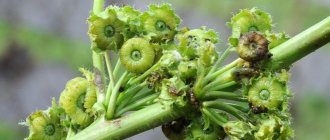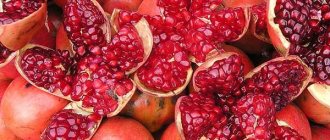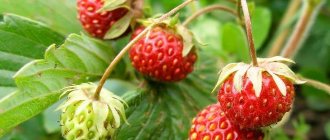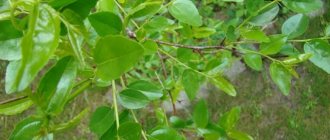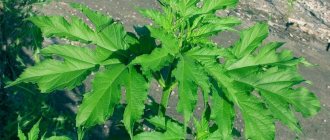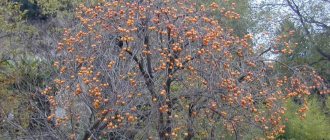Description of tarragon
Tarragon, known to professional botanists as tarragon wormwood, and to most Russians as tarragon, is a perennial herbaceous bushy plant. It is widely used in folk medicine and cooking. In nature, tarragon is most often found in Eastern Europe and Asia up to Mongolia and India. It is one of the closest “relatives” of the familiar wormwood, but its leaves are completely devoid of its characteristic bitterness. Rather, their inherent taste is reminiscent of anise.
In nature, tarragon successfully adapts to not always favorable climatic and weather conditions.
Russia became acquainted with tarragon relatively recently, in the 17th century, after the Transcaucasian states—Armenia, Georgia, and Azerbaijan—joined it. Until now, this spice is an integral part of Caucasian cuisine. This is where the local name “tarragon” came from. In Russia he received a number of nicknames - “dragon”, “snake”, “stragun”. The fact is that the rhizome of the plant, in fact, is somewhat reminiscent of this fairy-tale monster in shape.
The average height of a tarragon bush is 1.2–1.5 m. The leaves are narrow, lanceolate, with a smooth edge and a sharply pointed tip. Depending on the variety, their color varies from light green to rich dark green. Flowering is long lasting, lasting from early July to September. The flowers are small, spherical, collected in inflorescences in the shape of a basket or panicle. Their yellowish-white hue gradually changes to pinkish or pale red. Then the seed fruits ripen. The seeds in them are very small.
Tarragon bushes are not too tall, but without the supervision of a gardener they can quickly spread throughout the area
The rhizome of tarragon is very powerful, developed, “woody”. The stems are few, erect, yellowish-brown in color. They begin to branch closer to the top.
During the first season after planting seedlings or seeds in the ground, tarragon is not disturbed. The harvest begins to be cut only in the second year, since the plant spends the first year on the formation of the root system.
Tarragon blooms very modestly
Benefit for health
The characteristic spicy taste of the leaves is due to the presence of essential oils, resins, flavonoids and alkaloids in high concentrations. Tarragon is also rich in carotenoids, tannins, vitamins B and C, phosphorus, potassium, magnesium, selenium, sodium and iron.
Tarragon leaves are long and narrow, with a smooth edge
Vitamin C makes tarragon essential for strengthening the immune system. It can be included in the diet for spring vitamin deficiency or for recovery in the postoperative period. The positive effect of tarragon on strengthening connective tissues has been scientifically proven. It stimulates the production of collagen and elastin, and accordingly, is indispensable for joint diseases. In addition, greens normalize the activity of the gastrointestinal tract, stimulate the functioning of the endocrine glands, and help fight the symptoms of pulmonary diseases. The alkaloids contained in the spice are an effective means of fighting parasites. They are also useful for improving blood composition.
Nutritionists recommend including tarragon in the diet of those who adhere to a salt-free diet. It is also indicated for high blood pressure and kidney problems, and for women - for cycle disorders. Tarragon is also useful for improving appetite.
Tarragon can easily replace salt
There are also contraindications. Greens are prohibited from being consumed by epilepsy, gastrointestinal diseases in the acute stage (especially ulcers and gastritis), and by women at any stage of pregnancy. If you eat tarragon immoderately, nausea and vomiting are very likely, and in especially severe cases, even convulsions and loss of consciousness are possible.
Tarragon-flavored butter is extremely popular in French cuisine.
The spice is also in demand in cooking. In home canning, it is used by adding it to marinade for cucumbers and tomatoes, and to sauerkraut. Tarragon-infused oil and vinegar are popular in Mediterranean countries. Greens are included in many sauces. You can also make a refreshing tonic drink from tarragon. The taste of Tarragon sparkling water is probably familiar to many from childhood.
The refreshing and tasty drink “Tarragon”, familiar to many from childhood, is easy to prepare at home.
Video: how to prepare the Tarragon drink at home
Tarragon essential oil is widely used in aromatherapy and cosmetology. In the first case, it is believed that its aroma has the ability to calm, relieve causeless anxiety and depression, and normalize the state of mind after a nervous breakdown. Masks with tarragon oil tone the skin, improve color and even out complexion, smooth out fine wrinkles.
Video: description of tarragon and its health benefits
Interesting Facts
And some interesting facts about this amazing plant:
- Tarragon leaves contain sodium. Dried leaves can be used in a salt-free diet.
- The plant has long been known as an antidote to the bites of poisonous snakes.
- The aroma of tarragon depends on several factors. The maximum peak aroma of tarragon leaves is observed before it begins to bloom. The lower leaf blades are less fragrant than the upper ones.
- The famous drink Tarragon is almost the same age as the no less famous Coca-Cola. Both recipes were created and implemented by pharmacists, but in different parts of the globe.
Here is such an interesting spice - tarragon.
Common varieties
Tarragon is popular among plant breeders. Therefore, there are quite a lot of varieties bred by domestic and foreign specialists:
- Valkovsky. One of the oldest varieties known in Russia. The leaves are matte, the aroma is not too pronounced. The variety is early ripening, less than a month passes from the emergence of seedlings in the second season to the first cutting of the crop. Valued for its frost resistance, it rarely suffers from disease. Very negative attitude towards soil waterlogging;
- Gribovsky. The leaves are a rich emerald color, with a pronounced aroma, very delicate. It is cold resistant. It can be grown in the same bed without compromising its taste for up to 15 years. Greens can be cut after 1.5 months, then after another 3-4 weeks;
- Dobrynya. Low (up to 1 m) plant. Greens have a high content of carotenoids and vitamin C. They tolerate frost and prolonged drought well. The first time the greens are cut after 30 days, the second time after another 3 months. The variety can be grown in one place for up to 10 years;
- Zhulebinsky Semko. It has very high frost resistance. The bush is multi-stemmed, 0.6–1.5 m high. The lower part of the stems quickly becomes coarser and loses leaves. The aroma is characteristic, aniseed, the greenery has a sweetish aftertaste. Harvest the crops at monthly intervals. It grows in one bed for 5–7 years;
- King of herbs. The height of the densely leafy subshrub is 1–1.2 m. The greenery has a distinct anise aroma. Leaves are matte. The variety is cold-resistant, but does not tolerate drought very well. The first time the greens are cut is after 40 days, then only after 2.5–3 months. Harvest - about 4 kg/m²;
- Goodwin. One of the most common varieties. Subshrub about 1.15 m high, densely leafy. Suitable for growing at home. The leaves taste bitter. It is characterized by high productivity - each bush produces about 0.5–0.6 kg of green mass. The first time the crop is cut is after a month, then after 130 days;
- Monarch. The height of a powerful, highly branched plant is about 1.5 m. The leaves are bright emerald. The variety is characterized by good frost resistance. The taste is sharp and refreshing. The aroma inherent to the plant persists even after drying. The first cut takes place in a month or even a little earlier, 135 days pass before the second;
- Smagard. One of the shortest varieties (about 0.7–0.8 m). Stems are erect, densely leafy. The aroma of greenery is very pleasant and refreshing. It is frost and drought resistant. Used in landscape design. Productivity - up to 4 kg/m²;
- French. Recognized by culinary specialists as one of the best varieties, the greens are very aromatic. It is also valued for its high yield (0.5–0.7 kg of greens per plant) and “innate” immunity to diseases. It is used not only in cooking, but also in landscape design. Snow-white flowers contrast effectively with dark green leaves;
- Aztec. A Mexican variety of tarragon slightly “ennobled” by breeders. Bush up to 1.5 m high, intensively branched, densely leafy. Anise aroma, very pronounced. Greens can be grown in the same place for no more than 7 years without loss of quality;
- Gribovchanin. A very compact subshrub up to 0.8 m high. It stands out for its pale pink flowers. The leaves do not lose their tenderness and juiciness for a long time. Productivity - up to 0.6 kg of greenery per adult plant. A month passes before the first cutting, 120 days before the second. “One-time” harvest - 3 kg/m²;
- Grass. The bush is almost spherical (0.85 m in diameter with a height of 1–1.1 m). Stems are erect. The leaves have a high content of essential oils and do not lose their juiciness for a long time. The flowers are bright yellow.
Photo gallery: varieties of tarragon popular among Russian gardeners
Tarragon Valkovsky does not tolerate excessive watering Tarragon Gribovsky can be grown in one place for quite a long time without compromising the quality of the greens
Tarragon Dobrynya is valued for its high content of vitamins Tarragon Zhulebinsky Semko, due to its sweetish taste, is very good in drinks Tarragon The king of herbs reacts negatively to drought Tarragon Goodwin is one of the most popular varieties among Russian gardeners
Tarragon Monarch is a tall but fairly compact plant. The tarragon variety Smagard is popular because of its “miniature” appearance.
French tarragon is extremely highly valued by culinary specialists. The “ancestor” of Aztec tarragon comes from Mexico. Gribovchanin tarragon stands out for its flowers of a pastel pink hue.
Tarragon Herbal is distinguished by a high content of essential oils in greens
Application
The use of tarragon seasoning in cooking is very popular - this is due to its spicy, pleasant smell and fresh taste, which complements any dish.
If you want to expand your culinary options, you should add weed to the following dishes:
- Pickles and marinades - mushrooms, eggplants, cucumbers and tomatoes are especially good;
- Sauces for poultry and meat;
- Where dried tarragon is used - cheeses and curdled milk, meat soups and broths, egg dishes, vegetable dishes;
- Boiled, salted and baked fish;
- Lemonades and jam;
- Herbal teas;
- Alcoholic drinks – vodka, tincture and liqueur;
- Where is tarragon seasoning used fresh? It is especially good in vegetable salads.
We have figured out what dishes tarragon is added to - let us remind you that it is worth observing in moderation! Don't put too much so as not to interrupt the taste of the main dish. If using fresh sprigs, add them at the end. Seasoning that is subjected to heat treatment loses its taste.
Suitable conditions for growing tarragon
Tarragon is not particularly demanding when it comes to “keeping conditions.” The crop can be grown in the same place for up to 12–15 years, but practice shows that after 4–5 years it is better to change the bed. Otherwise, the greens lose their inherent taste and aroma, the stems become woody, and the leaves become hard.
It is advisable to give the plant a sunny place or an area in partial shade. It will not die in the shade either, but the aroma will not be pronounced. Almost any soil is suitable for it, with the exception of acidified and waterlogged soil. In nature, the culture survives calmly on almost bare rocks in the steppes. If groundwater comes close to the surface, tarragon is planted in ridges about 50 cm high. Otherwise, the rhizomes may rot. For the same reason, it is undesirable to place plantings in lowlands.
It is advisable to plant tarragon in a bed well warmed by the sun, only in this case the concentration of essential oils in the leaves will be maximum
Sand or rotted sawdust must be added to heavy soil. Dolomite flour, sifted wood ash, crushed chalk or powdered eggshells will help neutralize excess acidity. The ideal option is loose but fertile loam.
Dolomite flour is a natural soil deoxidizer; if the dosage is observed, the product has no side effects
The plant is bush-like, with “spreading” rhizomes, so when planting, leave at least 50 cm between the bushes. The same interval is maintained between rows of plantings.
Since the fall, the bed has been dug up to a depth of one shovel bayonet. Fertilizers include humus or rotted compost, Nitrophoska, Azofoska or other complex mineral fertilizers (10–15 g/m²). Fresh manure and excess nitrogen fertilizers are strictly prohibited. Tarragon has the property of accumulating nitrates. In spring, the substrate will need to be thoroughly loosened again.
Azofoska is a complex nitrogen-potassium-phosphorus fertilizer; you must strictly follow the dosage recommended by the manufacturer: its excess is harmful to tarragon
Good predecessors for tarragon are any legumes and green manure plants that saturate the soil with nitrogen. It develops poorly in the place where chicory, Jerusalem artichoke and green salad grew.
Jerusalem artichoke and tarragon have difficulty getting along side by side
Planting seedlings and tarragon seeds
Most often, tarragon is planted as seedlings. But no one forbids sowing seeds in the garden. They are very small in tarragon, so you need to try to sow them as evenly as possible. The time is chosen so that the likelihood of return spring frosts is minimal. In most of Russia, tarragon is sown in late May or early June, in warm southern regions - in the second half of April.
Before planting, the seeds are soaked for 10–12 hours in a solution of Epin, Zircon, Heteroauxin, or another biostimulant. Those that float to the surface can be thrown away. Then the seeds must be dried.
Epin, like other biostimulants, has a positive effect on seed germination
Tarragon is sown in furrows located at a distance of about 0.5 m from each other. First, they need to be thoroughly watered and allowed to soak in. Do not cover the top of the planting with soil, otherwise germination will sharply decrease.
Seeds germinate unevenly, after 15–25 days. During the first summer, it is advisable to protect seedlings from direct sunlight. To do this, build a canopy over the bed from any white covering material. When they grow to 4–5 cm in height, the seedlings are thinned out, leaving the most powerful and developed ones. The interval between them is at least 30 cm (optimally 50 cm).
When thinning, plants are not pulled out, but carefully cut with scissors.
Tarragon seeds do not germinate well, you will have to wait quite a long time
Further care of the plantings during the season consists of moderate watering (preferably from a spray bottle), fertilizing (about once a month, with organic fertilizers), careful loosening and regular weeding of the beds. For the winter, it is advisable to play it safe and protect the plants from possible severe frosts.
Caring for plants in open ground
Agricultural technology for tarragon is not particularly complicated. They weed it only in the first season after planting it in the ground. Then the rhizomes of the plants are tightly intertwined, preventing weeds from breaking through. They develop quite quickly and can soon “crawl” into neighboring beds, drowning out other crops. To avoid this, surround the area with tarragon around the perimeter with sheets of slate, digging them in to a depth of 20–25 cm.
Another option for protecting neighboring ridges is to place each bush in an old bucket without a bottom when planting.
Watering
Tarragon does not need too frequent watering, even in the heat. This can cause the roots to rot and the taste of the greens to deteriorate significantly. Once every 12–15 days is enough. It is advisable to water the plants by sprinkling, evenly soaking the soil to a depth of about 40 cm. And if the summer is cool and rainy, tarragon can generally make do with natural precipitation. You need to be especially careful with watering if tarragon is planted in the shade. After each procedure, about half an hour later, it is advisable to loosen the substrate between the rows.
Feeding
If the bed has been properly prepared, fertilizers are applied only from the second year in open ground. In early spring, before tarragon begins to grow, a mixture of 25 g of simple superphosphate, 15 g of potassium sulfate and 10 g of urea is scattered over the garden bed. Then the fertilizer is sprinkled with a thin layer of fertile soil. You need to act carefully so as not to damage the developing sprouts.
In the future, mineral fertilizers containing nitrogen are not applied. An excess of this macronutrient negatively affects the taste of greens; nitrates accumulate in the leaves. After each cutting, the plants can be fed with natural organic matter. To do this, fresh cow manure, bird droppings, nettle or dandelion leaves are infused in a container under a closed lid for 3-4 days (any weeds from the garden can be used as raw materials). Before use, the product is filtered and diluted with water in a ratio of 1:15 (for litter) or 1:8 (for everything else). Any store-bought fertilizers based on vermicompost and wood ash infusion are also suitable. The latter is a natural source of potassium and phosphorus, so in the fall you can sprinkle it in dry form under the roots of adult plants (about a handful per bush).
Nettle infusion is a natural source of phosphorus and potassium
Preparing for winter
Tarragon has high frost resistance, up to -35°C. Adult plants successfully winter without additional shelter in the Urals, Siberia and the Far East. But it is advisable to cover the seedlings transplanted this year in the fall with fallen leaves, sawdust, straw, pine needles, peat chips or humus, and cover them with spruce branches, creating a layer 8–10 cm thick. First, all the stems must be cut to the soil level, and the roots must be carefully dug.
Recent Entries
5 working ways to use tar in the garden 7 indoor plants that help you get married even in adulthood Indoor plants that can bloom in trouble
Tarragon wormwood and rosemary: are they the same thing or not and what is the difference?
Is this the same plant or not? They are similar in appearance, but there are several differences between them. Rosemary leaves are round and thick at the end, while tarragon leaves are sharp and thin. The first plant is grown as an annual (read more about growing tarragon here).
When dry and fresh, rosemary exudes a rich, resinous-pine aroma. It can overpower other odors, so it is handled with care in cooking. The smell of dried and fresh tarragon is not the same. Its dried leaves are characterized by a fragrant smell with sugary notes. Fresh branches give off an aniseed and mint aroma.
Growing tarragon at home
Tarragon bushes are not very large, so this crop can be grown at home. As a rule, the height of the bush in this case does not exceed 0.5 m. If you can get a cutting, you can root it, but it is much easier to buy seeds in the store. The productive life of a plant in captivity is 3–4 years. The best time for planting is early spring.
The dimensions of the tarragon bush allow it to be grown in a pot on a windowsill
The seeds are very small, so it is advisable to mix them with sand before planting. Tarragon is planted in small pots filled with universal soil for seedlings or a mixture of turf soil with coarse river sand or peat chips (3:1). A very fertile substrate for the crop is even harmful - the green mass increases intensively, but the content of essential oils in the leaves decreases. After planting, water the soil well. The water will “drag” the seeds to the required depth.
To make it easier to plant, tarragon seeds are mixed with sand.
A layer of expanded clay or other drainage material is required at the bottom of the pot. Place plastic bags on top of the containers or cover them with glass. Before germination, they are kept in a dark place at a temperature of 16–18°C.
To improve germination, seeds can be soaked in water at room temperature for 2–3 days. It will need to be changed daily.
Tarragon loves sunlight, but it is advisable to shade it from direct rays so that burns do not appear on the leaves. An eastern window sill is well suited for a pot. The optimal length of daylight is 10–12 hours. In autumn, winter and early spring additional lighting may be needed. Both regular fluorescent and special phytolamps are suitable for this. In summer, the pot can be taken out onto the loggia or glassed-in balcony.
Tarragon can be placed on the balcony or veranda for the summer
Most varieties do not tolerate heat very well; the leaves often wither. The optimal temperature is 18–20°C. The soil is watered only after the top layer has dried 2–3 cm deep.
Tarragon is fed in early spring and mid-autumn. Any universal complex fertilizers for garden crops with a low nitrogen content are suitable. The concentration of the product is halved compared to that recommended by the manufacturer.
Chemical composition of tarragon
The chemical composition of tarragon is quite diverse. The aerial part of the plant contains alkaloids, flavonoids, carotene, coumarins, phosphorus, tannins and, of course, essential oil of tarragon wormwood. The roots of the plant contain only faint traces of alkaloids, but do not contain other useful substances.
Consider an essential oil consisting of almost 90% thuyl alcohol. Tarragon does not have much of it: no more than 0.5% of the total mass of the plant. It contains numerous resins, ocimene, sabinene, phellandrene
Both the oil and the vegetative organs of Artemísia dracúnculus contain ascorbic acid, absinthine, saponids, malic acid, succinic acid, iron, potassium, rutin and even a small concentration of mercury. Fortunately, it does not pose a danger to humans, just like tarragon itself.
The chemical composition of tarragon allows it to be successfully combined with essential oils of lime, chamomile, wild carrot, fir or tangerine.
Reproduction methods
Tarragon reproduces both generatively and vegetatively. The first is resorted to if it is necessary to radically rejuvenate the plantings. The second helps to “disperse” the crop throughout the area and move it to a new place. It is much less labor intensive and allows you to get a harvest faster.
Dividing the bush
The method is suitable for plants aged 3–4 years and older. As soon as the soil warms up enough, the bush is dug out of the ground and divided into several parts so that each has 2-3 growth buds. It is advisable to unravel the roots by hand, and resort to scissors and a knife as a last resort.
The roots are easier to unravel if you soak them in water for several hours.
When dividing a tarragon bush, use scissors only as a last resort.
Parts of the plant are immediately planted in a new place and watered moderately. For the first 2–3 weeks, it is advisable to protect them from direct sunlight. Practice shows that tarragon takes root faster if you cut the existing stems by half. This reduces the evaporation area.
You can plant not even part of the bush, but a piece of rhizome 7–10 cm long. They are placed horizontally in the soil, pre-soaked in any biostimulant for 2–3 hours. Before planting, the cuttings must be sprinkled with crushed chalk, activated carbon, and sifted wood ash.
Cuttings
Tarragon stalk is the upper part of the shoot, approximately 12–15 cm long. They are cut closer to mid-summer, in late June - early July. By this time, the “donor” bush has managed to increase its growth enough to avoid stress.
Tarragon cuttings are cut in mid-summer
The cut is made at an angle of 40–45°. The leaves on the lower third of the cutting are torn off. Then it is soaked for 6–8 hours in a solution of any biostimulant. You can also use aloe juice, succinic acid and even honey. The cuttings are planted in pots, a greenhouse, a greenhouse, or immediately in a permanent place. In the latter case, before rooting, they are covered with cut plastic bottles or glass caps. The optimal temperature for tarragon development is 18–20°C, so the plantings will have to be ventilated regularly.
A homemade “greenhouse” helps tarragon cuttings take root faster, but it needs to be ventilated regularly
Rooting usually takes 2–3 weeks. After another 10–15 days, young plants form 1–2 new shoots. After this time, they can be transferred from the greenhouse or greenhouse to a permanent place. The cuttings are removed from the ground along with a lump of soil, trying to injure the roots as little as possible.
Practice shows that if tarragon is propagated for a long time by any vegetative method, it loses its ability to bloom. The taste and aroma of the greens are not lost.
Reproduction by layering is similar to cuttings. One of the stems is bent, cut from below and pinned to the ground in the middle, filling this place with humus. During the summer, abundant watering is required. By next spring, roots should appear in this place. In May, the cuttings can be separated from the mother bush and transferred to a permanent place.
Propagation by layering is practiced for a wide variety of garden crops.
Germination of seeds
The seedling method of growing tarragon is quite labor-intensive, but it is the method most often practiced in Russia. You can collect the seeds yourself or purchase them at the store. They retain germination for 3–4 years. Tarragon is sown for seedlings in the middle or end of March.
It is worth noting that when grown from one’s own seeds for a long time, the crop gradually “degenerates”, so it is advisable to update the planting material from time to time.
Tarragon seeds take a long time to germinate, even if pre-planting preparation is carried out
Planting process:
- Seeds are soaked for 10–12 hours in a solution of any biostimulant (to improve germination) or a pale pink solution of potassium permanganate (for disinfection). To prevent fungal diseases, they are pickled for 15–20 minutes in any fungicide of biological origin (Bayleton, Alirin-B, Baikal-EM). Then the seeds need to be dried.
- A shallow container is filled with a mixture of turf soil and peat or sand (3:1). The soil is moderately moistened and leveled. The seeds are sown, having previously mixed them with fine sand, in shallow furrows. Then the plantings are watered again. The seeds are not covered with anything on top.
- The containers are covered with glass or plastic film and kept in the dark at a temperature of 16–18°C until germination. As the soil dries, moisten it with a spray bottle, and the greenhouse is regularly opened for 5–10 minutes to get rid of accumulated condensation.
- When the shoots appear (you will have to wait at least 2 weeks), the shelter is removed and the container is moved to the best-lit place in the apartment. Water the seedlings very sparingly.
- After about a month, the seedlings sprout (the plants should already have at least two true leaves). The distance between them is 7–10 cm.
- At the beginning of June, the seedlings can be transferred to a permanent place. About a week before this, it needs to be fed by spraying it with a solution of any nitrogen-containing fertilizer (1–2 g per 1 liter of water). Immediately after planting, it is advisable to tie the seedlings to supports of suitable thickness. The stems of young tarragon plants are quite thin and break easily.
Growing tarragon from seedlings is a rather labor-intensive method, but you can get a harvest faster
Where does it grow
It is difficult to name an area where tarragon is not found. But it is believed that the birthplace of this spice is Mongolia and Eastern Siberia.
Since the 17th century, the seasoning began to be used in France. Until this time, this plant, which has a very delicate pleasant taste and aroma, is cultivated there and is actively consumed as food. Russia (except the Urals) is a country where the spice grows, the characteristic features of which are short leaves, a rougher smell and taste, and a lack of sweetness.
Tarragon plantation in France
Photo of the plant
The varieties growing in Ukraine, the Urals and Transcaucasia have a more aromatic tarragon In Mexico, tarragon has a pungent and spicy taste.
Diseases and pests
The high concentration of essential oils and alkaloids in tarragon leaves effectively repels many pests from plants. They practically do not suffer from diseases, having naturally high immunity.
The exception is leaf rust. The front side is covered with pinkish swellings, the back side is covered with a continuous layer of fleecy saffron-colored coating. Gradually it thickens and darkens, the affected leaves dry out and fall off. The spread of the disease is facilitated by overfeeding plants with nitrogen and excessive thickening of plantings.
Leaf rust is a common fungal disease.
For prevention, seeds are pickled for 15–20 minutes in a solution of any fungicide of biological origin. During the season, the soil in the garden bed is dusted with crushed chalk and sifted wood ash.
If the disease is noticed in time, it is quite possible to cope with it using folk remedies - foam of laundry soap, soda ash diluted with water, a bright pink solution of potassium permanganate, diluted kefir or whey with added iodine (10 drops per 10 liters) are suitable. If there is no effect, any fungicides are used: old time-tested means (copper sulfate, Bordeaux mixture) or modern copper-containing preparations (Skor, Horus, Zineb, Raek, Topaz).
Of the pests, the greatest damage to tarragon plantings can be caused by aphids and wireworms (the larva of the click beetle). Aphids feed on plant sap, being extremely omnivorous. It clings to the tops of shoots, young leaves, and flower buds in entire colonies. The affected parts of the plant turn yellow, then become discolored and dry out.
Whole colonies of aphids cling to the tops of plants
The pest really does not like strong odors, so for prevention, you can plant marigolds, nasturtiums, and lavender next to tarragon. Infusions of onion and garlic arrows, tomato tops, orange peels, and dry tobacco leaves effectively repel aphids. They will also help get rid of the pest if it has not yet multiplied en masse. Only the frequency of treatments will have to be increased from once every 12–15 days to 2–3 times a day. In the absence of the desired result, use any general insecticides - Inta-Vir, Iskra-Bio, Admiral, Calypso, Confidor-Maxi.
The wireworm chews through the roots of plants, they quickly dry out and die. For prevention, leaf mustard, beans, and other green manure plants can be planted between the rows; the bed can be dusted with tobacco dust. Traps also have a good effect - containers dug into the ground filled with pieces of raw potatoes, carrots, and beets. In case of mass pest invasion, the drugs Provotox, Bazudin, Pochin are used.
The wireworm chews through the roots of plants, leading to their death.
Contraindications
When overeating tarragon and excessive consumption of products based on it, symptoms of acute poisoning are observed: nausea, vomiting, chills, loss of appetite, convulsions. Before starting treatment with tarragon, consultation with a specialist is necessary.
Contraindications to the use of tarragon:
- gastritis;
- peptic ulcer;
- increased acidity of gastric juice;
- During pregnancy and breastfeeding;
- individual intolerance.
